

Introduction to the history
It gives us great pleasure to offer you an insight into our “treasure trove”. With the help of a number of our precious items, we want to give you an overview of the history of our House.
Jakob Heinrich Köchert, Emmanuel Pioté, Alexander Emanuel Köchert
1814
Frenchman Emanuel Pioté opens up a goldsmiths’ workshop in Vienna. The Congress of Vienna begins the same year. Thanks to his artistic enamelling work, it is not long before Pioté acquires an outstanding reputation.
Cross pendant: gold and emeralds, c. 1820

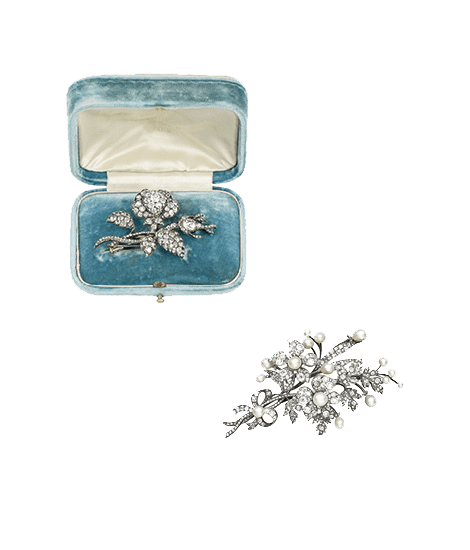
1819
Jakob Heinrich Köchert, originally from Riga, applies to work for Pioté. He marries the Frenchman’s sister-in-law, and soon becomes a partner in the ambitious goldsmiths’ business. Köchert brings the art of mounting large gems with him from St. Petersburg, where he has spent his years as an apprentice.
Flower brooch: diamonds and pearls, c. 1850
1827
Prince von Metternich, the most important client – and mentor – of “Pioté et Köchert”, sends a valuable armband to the lady who has captured his heart, the Duchess of Lieven, with the words: “To the things one manages to achieve in Vienna in style, belongs everything to do with jewellery and precious stones.”
Flower tiara: diamonds, c. 1840
Duchess of Lieven with jewelry from Pioté und Köchert, c. 1820
Tag: „Pioté & Köchert,
Joailliers de la Cour de S.M.I. & R.“


1831
The Austrian Emperor Franz I – the “Kaiser”- commissions the ambitious company to produce a gold box for the Turkish ambassador. A year later, the coveted honorary title of “Kaiserlich Königlicher Hofjuwelier”, or “Imperial Royal Court Jeweller” is bestowed upon Pioté and Köchert.
Gold box engraved, c. 1830
1838
Production of the imperial insignia to mark the coronation of Kaiser Ferdinand as King of Lombardy-Venetia.
Emperor Franz I, 1832
Emperor Ferdinand I, ca. 1838
Design: Orb of Lombardy-Venetia by Peter Fendi c. 1838

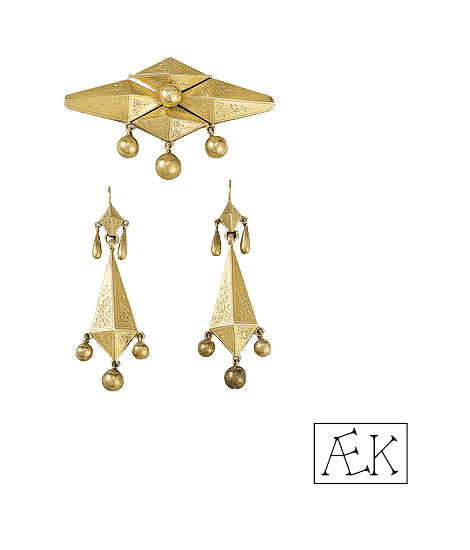
1844
Alexander Emanuel Köchert joins the company. Under his stewardship, Köchert is destined to become one of Europe’s foremost jewellery houses. To this day, every piece of jewellery which leaves the workshop at the company’s headquarters on Neuer Markt is hallmarked with his initials, “AEK”.
Brooch and earrings: Gold, c. 1835; hallmark AEK
1849
Not quite 50 years after its founding, the company Köchert is already about to reach its first high point: Kaiser Franz Joseph appoints Jakob Heinrich Köchert as his personal jeweller – the Imperial Royal Court and Chamber Jeweller.
Picture frame: Franz Joseph I, enamel, various gemstones, 1873

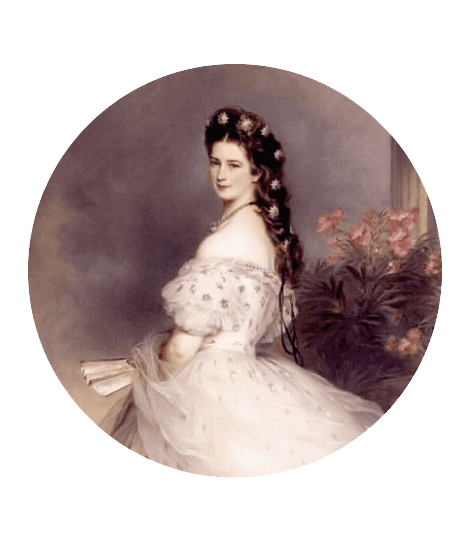
1854
Six years after his coronation as the Austrian Kaiser, Franz Joseph marries the ravishingly beautiful Princess Elisabeth von Bayern. That same year, Alexander Emanuel Köchert takes over the management of the company from his father.
Empress Elisabeth with diamond stars from the House Köchert, 1865
1858
Kaiser Franz Joseph commissions Köchert to create a set of 27 diamond stars for Elisabeth – “Sisi” – which the Kaiserin has artistically plaited into her hair. By doing so, Sisi triggers a fashion throughout Europe: suddenly, stars are en vogue wherever one looks.
Design drawings and photos: diamond stars of empress Elisabeth, c. 1860


1865
In the second half of the 19th century, the age of Historicism, the predilection for décor and vibrant colours is revived in Vienna – presages of Art Nouveau, which is destined to play such a key role in shaping the handicrafts and art of the capital a few years later. Kaiserin Elisabeth acquires a brooch in the Historicist style from Köchert
Brooch in Brooch in the style of historicism for Empress Elisabeth: diamonds, pearls, enamel, c. 1865
1870
As the Chamber Jeweller, Alexander Emanuel Köchert is also entrusted with the supervision of the Imperial treasury. Under his guidance, the Austrian imperial crown is furnished with an intricate edging of pearls. By doing this, Köchert completes the previously unfinished imperial regalia.
Austrian imperial crown, completed by Alexander Emanuel Köchert in 1870


1873
The famed Ringstraße architect Theophil von Hansen, already responsible for creating such Viennese gems as the Musikverein, Parliament and Stock Exchange, designs the company’s new business premises in the Maysederhaus at Neuer Markt 15. He also designs other items, including the Byzantine tiara and the Swan Trilogy, for which the House of Köchert is awarded first prize by an international jury at the Vienna World’s Fair in 1873.
“Schwanenparure” necklace and earrings by Theophil v. Hansen: 1st Prize World Exhibition 1873
1875
Following the death of his predecessor Kaiser Ferdinand I, Kaiser Franz Josef inherits a vast fortune, and extensive commissions are received from the royal house as a result. One high point amongst these is the vine leaf set, a jewellery combination created for Kaiserin Elisabeth using emeralds and diamonds taken from a corsage of Maria Theresia’s.


1880
Heinrich and Theodor Köchert take over the helm at the company – the third generation of the family to do so. Something like 50 goldsmiths are now creating outstanding, much-admired tiaras and necklaces at the House of Köchert. By now, Köchert is being mentioned in the same breath as the other great jewellers of Europe, such as Mellerio, Boucheron and Cartier.
Brooch: rubies, diamonds, pearl, c.1890
1885
Köchert’s regular clients now include numerous aristocrats and families belonging to the nobility. The Köchert family, who have a deep love of the arts, foster intense contacts with visual artists and musicians including Brahms, Bruckner and Hugo Wolf, who is provided with financial support by Heinrich and Melanie Köchert.
Design drawing and brooch: diamonds and sapphires, c. 1897


1889
Following the death of Crown Prince Rudolf, Kaiserin Elisabeth withdraws from the Viennese court almost entirely. It is Elisabeth herself who introduces the Kaiser to the popular actress Katharina Schratt, whose passion for jewellery surpasses even that of the Kaiserin.
Fuchsia brooch: diamonds and rubies, gift from the Kaiser to Katharina Schratt, c. 1900
1908
As the Ottoman Empire gradually collapses, a series of new monarchies, such as the Tsardom of Bulgaria, begins to emerge along Europe’s eastern border. The crown jewels of the new tsardom are ordered from Köchert. An exquisite tiara of lilies is produced for Tsarina Maria Louisa, who has originally been born into the Bourbon family.
Maria Louisa of Bulgaria; design drawing: tiara of lilies for Tsarina Maria Louisa of Bulgaria, c. 1910


1911
Following the morganatic marriage of the heir to the Austrian throne, Franz Ferdinand, to Countess Sophie Chotek, the young Archduke Karl becomes the next claimant to the imperial throne. To mark his marriage to Zita von Bourbon-Parma, the Kaiser himself commissions his Chamber Jeweller to produce a magnificent diamond tiara.
Wedding of Kaiser Karl and Zita, with bridal jewellery from the House of Köchert, 1911; necklace: diamonds and sapphires, c. 1910
1916
The death of Kaiser Franz Josef at the height of World War I heralds the end of an era. His successor, the young Kaiser Karl and his wife Zita, order a vast array of pieces of jewellery of all shapes and sizes featuring their initials from Köchert. These are used to honour personalities deemed worthy, or serve as gifts for guests at the royal household.
Design drawing: Karl and Zita armband; “K” armband: gold, enamel and diamonds, gift to guest from Kaiser Karl, c. 1915
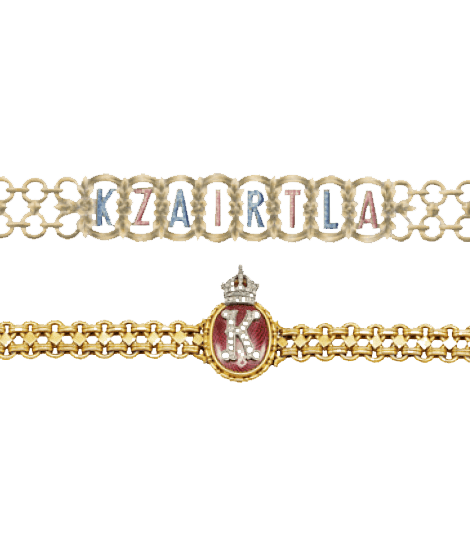

1918
Following the collapse of the Hapsburg Empire, Vienna remains the cultural and economic – if no longer political – centre of the sprawling central and eastern European region. This signals the beginning of the period that has come to be known as the “Roaring Twenties”, with old and new money alike spending uproariously in the Austrian capital and adorning itself in the very latest styles of jewellery.
Butterfly brooch: emeralds, rubies and diamonds, c. 1915; design drawings: brooches in Art Nouveau style, c. 1910
1920
The economic crisis of the 1920s sees vast fortunes simply evaporate in value just as quickly as they have been accrued. This is not a bad time for jewellers, as jewellery becomes a highly sought-after port in a storm, as a stable investment during periods of hyperinflation. The turbulent social changes being undergone also see the emergence of a new style: Art Deco.
Design drawings: armbands in Art Deco style, c. 1930


1922
After taking over the company, Theodor’s sons Erich and Wilfried Köchert guide it skilfully into a new era. Erich’s half-brother, the painter Erwin Lang, designs unique pieces of jewellery. He is to help shape the design of the House of Köchert until the 1960s. His stone rings evolve into genuine classics, and continue to be produced at the company’s workshop to this day.
Stone ring: onyx and peridot, after a design by Erwin Lang, 2008
1925
A fertile interaction evolves with other creative centres in the city, such as the Wiener Werkstätte. Some of the techniques originally developed by the Wiener Werkstätte, including the finessed knotting technique of the Coccinelle line, continue to be used at Köchert to this day.
Design drawing by Erwin Lang for a “Collier de Chien”, c. 1925; “Coccinella” earrings: diamonds and corals featuring knotting technique of the Wiener Werkstätte, 2014


1928
As a consequence of the break-up of the Ottoman Empire, Albania, too, becomes a monarchy. The country’s new rulers desire sufficiently prestigious jewellery, and turn confidently to the Kaiser’s jeweller to fulfil their needs. King Zogu’s crown, along with a tiara for each of his six sisters, are created by the House of Köchert.
Cigarette case: gold and enamel, design by Erwin Lang, c. 1930; design drawing: Capricorn tiara for the wife of the Albanian king, c. 1930
1945
The Second World War, and subsequent construction of the Iron Curtain just a few kilometres east of Vienna, prove to be further major turning-points for the House of Köchert. It means important markets are lost overnight – while at the same time, new such opportunities are born with the beginning of mass tourism.
Brooch: diamonds and pearls, design by Erwin Lang, c. 1948


1955
Under Gotfrid Köchert – famed as the “racing jeweller” due to his passion for yacht racing – and Dietrich Köchert, the House of Köchert consolidates an enviable reputation as a specialist in refined high-carat precious stones and classic jewels. After the catastrophe of the World War, there is huge pent-up demand for jewellery. In 1956, when the Opera Ball is celebrated for the first time since the war, jewels from the House of Köchert can be seen to truly twinkle once again.
Necklace: emeralds, diamonds and rubies, design by Erwin Lang, c. 1955;
brooch: emeralds and diamonds, design by Erwin Lang, c. 1960
1986
Dieter Köchert revives the company’s age-old tradition of collaborating with artists. These include the architect Hans Hollein, who designs a collection for the House of Köchert with great success. Contemporary artists and designers continue to be key partners of the company to this day.
“Träger“ brooch, Hans Hollein, 1986


1991
Following the untimely death of their father, Christoph and Wolfgang step in and take over responsibility for the destiny of the House of Köchert. Working on the basis of a long history in jewellery, they develop a new, classically Köchert style; “Sisi’s Stars” are revived using the original designs, and prove to be a triumph. But there’s more. The Köchert watch is introduced, and finally, in 20xx, a second luxury outlet is opened, in Salzburg, under the finessed management of Florian Köchert.
Köchert watch: 18kt gold, available since 1995
“Kaiserin Elisabeth“ diamond star, 2014
Christoph, Wolfgang and Florian Köchert
2001/2005
Florian Köchert joins the company in 2005. A second store opens in Salzburg under his management.


2014
To mark the occasion of the anniversary of the 200-year-old founding of the company, an “Anniversary Collection” is developed with major Austrian artists
2015
Renovation and redesigning of business premises and workshop at Neuer Markt together with BWM-Architekten.
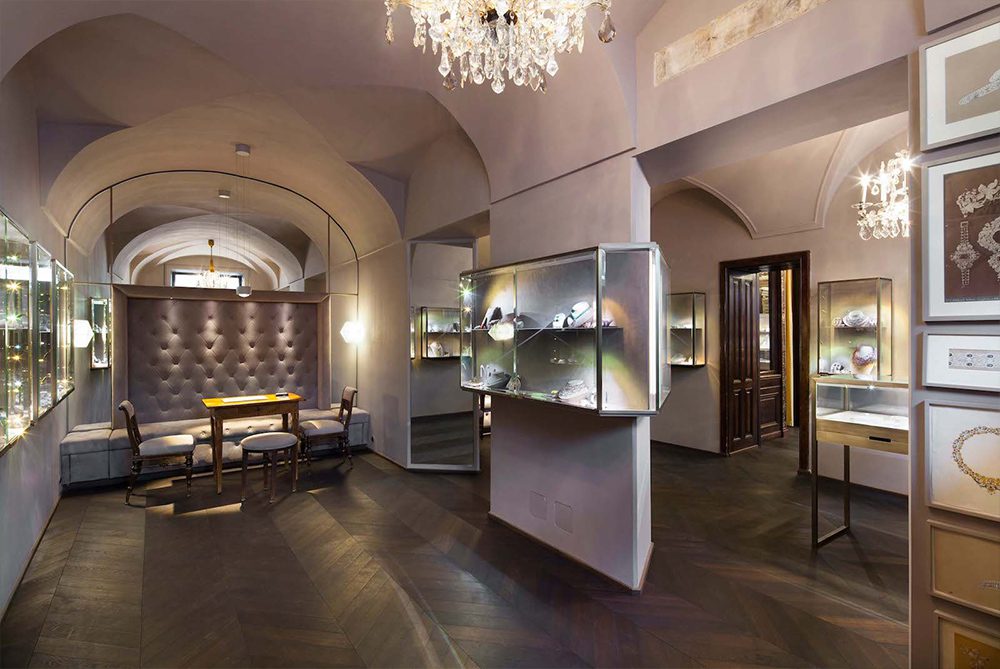

2021/22
After overcoming the challenges of operating through a huge building site lasting three years, Neuer Markt rises from the ashes in all its new splendour. It is quickly restored to its rightful place as one of the most beautiful spots in central Vienna.



